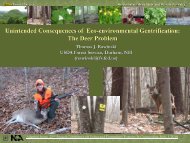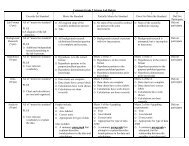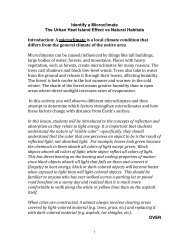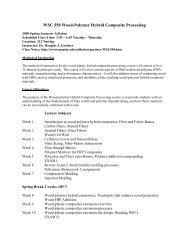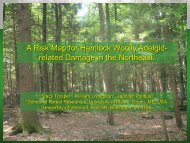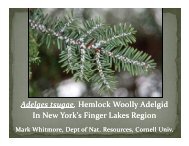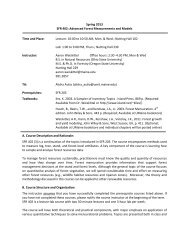eFFECTS OF WHITEMARKED TUSSOCK MOTH (ORGYIA ...
eFFECTS OF WHITEMARKED TUSSOCK MOTH (ORGYIA ...
eFFECTS OF WHITEMARKED TUSSOCK MOTH (ORGYIA ...
Create successful ePaper yourself
Turn your PDF publications into a flip-book with our unique Google optimized e-Paper software.
COMPARISON <strong>OF</strong> THE EFFICACIES <strong>OF</strong><br />
OrleSNPV AND OpMNPV IN LARVAL <strong>ORGYIA</strong><br />
LEUCOSTIGMA IN THE LABORATORY AND THE<br />
FIELD<br />
Garrett Brodersen*, Renée Lapointe,<br />
Graham Thurston, Chris Lucarotti and<br />
Dan Quiring
Nucleopolyhedroviruses<br />
• Nucleopolyhedrovirus (Fam. Baculoviridae)<br />
• The viruses are ingested in “packages” (occlusion bodies), and are<br />
released in the midgut when the envelope digests<br />
• Viruses infect midgut cells and pass through into the body cavity where<br />
they spread through the tissues, eventually killing the host.
Relevance?<br />
• Contrary to many other forms of insect control, NPVs are<br />
generally very host species-specific<br />
• Successfully used in Brazil and China in agriculture<br />
• Used in forestry to control Douglas fir tussock moth<br />
(OpMNPV), Gypsy moth (LdMNPV) and Balsam fir sawfly<br />
(NeabNPV) outbreaks in North America.
The Whitemarked Tussock Moth<br />
• Polyphagous defoliator<br />
• Range from eastern Canada to Manitoba<br />
• Population explosions occur approx. every 7 years<br />
• Susceptible to OrleSNPV and OpMNPV
General Objective<br />
• Two viruses, one native to western North America<br />
(OpMNPV) and the other to Maritime Canada (OrleSNPV),<br />
are proposed for use in controlling the whitemarked tussock<br />
moth<br />
• OpMNPV has already been registered, but OrleSNPV has not<br />
• The objective is to determine which virus is more efficacious<br />
in larval WMTM
Laboratory Objectives<br />
• Range-Finding Bioassays<br />
– Find LC 50 (2 nd instar) and LD 50 (4 th instar) for each<br />
virus<br />
• Lethal Time Bioassays<br />
– Find LT 50 (2 nd and 4 th instar) of each virus
2 nd instar WMTM larvae<br />
were droplet-fed a range of<br />
occlusion body (OB)<br />
concentrations of each virus<br />
for 15 min<br />
LC 50/LD 50 Bioassays<br />
4 th instar WMTM larvae<br />
were left to feed on<br />
artificial diet ‘plugs’ soaked<br />
with a known concentration<br />
of virus OBs for a day
• After feeding, larvae were placed individually<br />
on artificial diet and checked daily for 10 days
Mortality at Day 10 Post-Infection<br />
• In 2 nd instar WMTM larvae, OpMNPV’s LC 50 was 10x less than<br />
OrleSNPV.<br />
• No difference in 4 th instars
LT50 Bioassays<br />
• 2nd and 4th instar WMTM larvae were fed LC/LD 85 of<br />
each virus and checked every 12 hours for mortality rates
LT50<br />
• POLO shows that LT 50 of OrleSNPV < LT 50 of OpMNPV (2 nd<br />
instars); however, ANOVA showed no significant difference<br />
• Both POLO and ANOVA showed no difference for 4th instars
Lab Summary<br />
• The lab bioassays have shown that:<br />
– OrleSNPV kills 2 nd instars half a day sooner<br />
than OpMNPV<br />
– OpMNPV’s LC50 is 10x less than OrleSNPV<br />
– No difference in efficacy among 4 th instars
In Summary…<br />
• When fed to lab-reared 2 nd instar WMTM<br />
larvae, OpMNPV is 10x more efficacious than<br />
OrleSNPV. OrleSNPV, however, kills 2 nd instar<br />
larvae half a day sooner. No discernible<br />
difference in 4 th instars.
Final Word<br />
• Since both viruses have similar efficacies,<br />
there seems to be little reason to pursue<br />
OrleSNPV as a candidate for the biological<br />
control of WMTM.<br />
• However, from an environmental perspective,<br />
it may be prudent to use OrleSNPV within its<br />
native range to preserve the integrity of the<br />
eastern North American ecosystem.
Acknowledgements<br />
• David Thumbi, Sylvar Inc.<br />
• Laura Forbes, Sylvar Inc.<br />
• Kristy Robinson, Sylvar Inc.<br />
• Lisa Friar, Sylvar Inc.<br />
• Stephan Richard, Sylvar Inc.<br />
• Drew Carleton, UNB<br />
• Dillon Anthony, Berklee<br />
• Caitlin Tarr, UNB<br />
• Laura Buckingham, UNB<br />
• Colin Baptiste<br />
• Maxime Chautard<br />
• The Atlantic Innovation Fund (AIF)<br />
• Forest Protection Ltd. (FPL)<br />
• Nova Scotia Dept. of Natural<br />
Resources (NS-DNR)<br />
• NSERC<br />
• The University of New Brunswick<br />
(UNB)<br />
• Canadian Forest Service (CFS)




